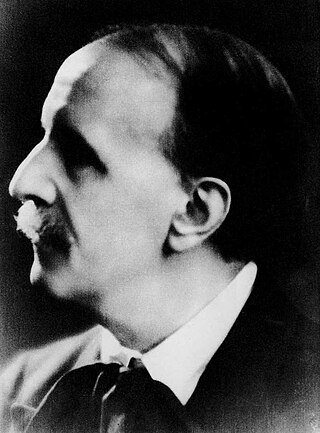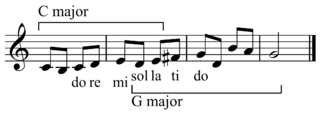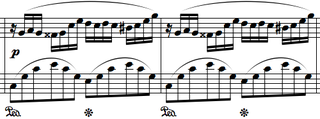In music theory, the key of a piece is the group of pitches, or scale, that forms the basis of a musical composition in Western classical music, art music, and pop music.
Tonality or key: Music which uses the notes of a particular scale is said to be "in the key of" that scale or in the tonality of that scale.

Maurice Gustave Duruflé was a French composer, organist, musicologist, and teacher.

Louis Victor Jules Vierne was a French organist and composer. As the organist of Notre-Dame de Paris from 1900 until his death, he focused on organ music, including six organ symphonies and a Messe solennelle for choir and two organs. He toured Europe and the United States as a concert organist. His students included Nadia Boulanger and Maurice Duruflé.

In music, modulation is the change from one tonality to another. This may or may not be accompanied by a change in key signature. Modulations articulate or create the structure or form of many pieces, as well as add interest. Treatment of a chord as the tonic for less than a phrase is considered tonicization.
Modulation is the essential part of the art. Without it there is little music, for a piece derives its true beauty not from the large number of fixed modes which it embraces but rather from the subtle fabric of its modulation.
The Westminster Quarters, from its use at the Palace of Westminster, is a melody used by a set of four quarter bells to mark each quarter-hour. It is also known as the Westminster Chimes, Cambridge Quarters or Cambridge Chimes from its place of origin, the Church of St Mary the Great, Cambridge.
In Western musical theory, a cadence is the end of a phrase in which the melody or harmony creates a sense of full or partial resolution, especially in music of the 16th century onwards. A harmonic cadence is a progression of two or more chords that concludes a phrase, section, or piece of music. A rhythmic cadence is a characteristic rhythmic pattern that indicates the end of a phrase. A cadence can be labeled "weak" or "strong" depending on the impression of finality it gives. While cadences are usually classified by specific chord or melodic progressions, the use of such progressions does not necessarily constitute a cadence—there must be a sense of closure, as at the end of a phrase. Harmonic rhythm plays an important part in determining where a cadence occurs. The word "cadence" sometimes slightly shifts its meaning depending on the context; for example, it can be used to refer to the last few notes of a particular phrase, or to just the final chord of that phrase, or to types of chord progressions that are suitable for phrase endings in general.

Frédéric Chopin's Fantaisie-Impromptu in C♯ minor, Op. posth. 66, WN 46 is a solo piano composition. It was composed in 1834 and published posthumously in 1855 despite Chopin's instruction that none of his unpublished manuscripts be published. The Fantaisie-Impromptu is one of Chopin's most frequently performed and popular compositions.
The French organ school formed in the first half of the 17th century. It progressed from the strict polyphonic music of Jean Titelouze to a unique, richly ornamented style with its own characteristic forms that made full use of the French classical organ. Instrumental in establishing this style were Louis Couperin, who experimented with structure, registration and melodic lines, expanding the traditional polyphonic forms, and Guillaume-Gabriel Nivers (1632–1714), who established the distinct forms and styles of what was to become the French organ tradition.
Pierre Eugène Charles Cochereau was a French organist, improviser, composer, and pedagogue.
Pierre André Labric is a French organist, pedagogue and composer.
"La cathédrale engloutie" is a musical composition written by the French composer Claude Debussy for solo piano. It was published in 1910 as the tenth prelude in Debussy's first book of preludes. It is characteristic of Debussy in its form, harmony, and content.
The Symphony for Organ No. 5 in F minor, Op. 42, No. 1, was composed by Charles-Marie Widor in 1879, with numerous revisions published by the composer in later years. The full symphony lasts for about 35 minutes.
David M. Patrick is an English organist. He was educated at Exeter School and then pursued his musical education at the Royal College of Music in London with distinction winning the Stuart Prize for organ in 1967 and going on to gain the Walford Davies Prize the following year. This award brought him recitals at both Westminster Cathedral and Westminster Abbey as well as being presented to Queen Elizabeth the Queen Mother.
Les Corps Glorieux is a large organ cycle composed in the summer of 1939 in Saint-Théoffrey (Isère) by Olivier Messiaen. The work was completed on 25 August 1939, a week before the declaration of the Second World War and was premiered by Messiaen himself on 15 April 1945 at the Palais de Chaillot. This work marks an evolution in the musical language of Olivier Messiaen, combining features of both Indian classical music and Gregorian chant. The work, together with L'Ascension (1934) and La Nativité du Seigneur (1935), is one of the three early organ cycles of the composer.

Jean-Luc Perrot is a French organist, carillonneur, composer and musicologist.
Adolphe Alexandre Silvain Marty was a French organist, improviser, composer and music educator who was blind for most of his life.

Vingt-quatre pièces en style libre, Op. 31, by Louis Vierne for organ or harmonium were written in two volumes during the years 1913 and 1914.
Méditations sur le Mystère de la Sainte Trinité is a work for organ by the French composer Olivier Messiaen. It was composed from 1967 to 1969 at Messiaen's house in Pétichet.

Lynnwood Farnam was a Canadian organist who became the preeminent organist in North America in the 1920s until his death. He was influential in promoting the music of Bach, and also championed French organ music contemporary to his day. He became acquainted with the most important American and European organists of his day, and upon his early death several major works were dedicated in to his memory. He was known for his superb technical ability and knowledge of organ registration, but he avoided performances intended to "show off" the organist, preferring the attention to be drawn to the music.

The Prélude, usually affixed with the subtitle pour orgue, is an organ piece in E major by French composer Olivier Messiaen. The work, which dates from the 1920s, is, along with the Offrande au Saint Sacrement, the earliest surviving organ work of the composer. Scholars differ as to the exact date and purpose as to when and why it was composed.









